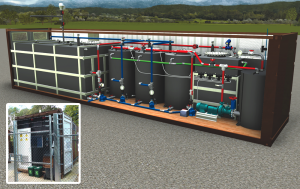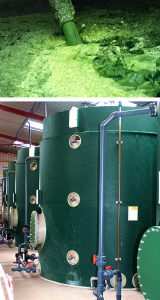David Riggle
The anaerobic Digestion and Biogas Association’s fourth annual trade show and conference — UK AD & Biogas 2013 — attracted a busy stream of visitors to Birmingham, England in early July, demonstrating a growing interest in this vibrant industry sector. The event included facility tours, conference sessions, workshops, free one-on-one consultations with industry experts, launch of ADBA’s new Practical Guide to AD (article to follow in a future issue of BioCycle), and a trade show.
This year’s event had a total of 240 exhibitors — primarily from the UK and Europe — representing digester manufacturers from small-scale to large-scale and all stages in between. Farm-fed and waste-fed technologies were represented alongside companies making or selling the valves, grinders, pumps, mixers, macerators and related engineering needed to operate a facility as well as the application equipment needed to utilize the biogas and digestate. Biomethane vehicles were on display, as were companies supplying control solutions to operational issues, as well as policy or planning advice. The Wales Centre of Excellence for Anaerobic Digestion, The Chartered Institution of Wastes Management and the Waste and Resources Action Programme (WRAP) all had a strong presence.
The event itself felt energetic and engaged. Over 100 anaerobic digestion plants have now been built in the UK (not counting the 146 operating in the water industry) and more are at earlier stages of development. “I am pleased to say that the growth in the UK AD industry in the last five years has indeed been hugely impressive,” says Charlotte Morton, ADBA’s Chief Executive. “The future potential is even more exciting still.” Some of the companies that exhibited are presented in this article.

SEaB Energy’s compact anaerobic digestion system
Self-Contained, Micro AD
SEaB Energy’s compact anaerobic digestion systems can begin producing biogas, energy, a liquid fertilizer and mulch with as little as half a ton of incoming organic waste per day (150-250 tons/year). The design is scalable with a starting footprint the size of three 20-foot shipping containers, increasing to seven containers of the same size to handle around 3 tons/day (1,250 tons/year). Based on the outskirts of Southampton, UK, SEaB has developed two turnkey AD systems. The first, Muckbuster®, is best suited for manures and crop processing. Flexibuster™ is optimum for food waste and green wastes. A key advantage of these smaller on-site units is they minimize transportation costs for wastes from food processors, breweries, restaurants, farms and food retailers.
One installation at the University of Southampton Science Park (USSP) utilizes a mix of food waste, cooking oil and spent alcoholic drinks collected from Chilworth Manor Hotel, situated within the Science Park, along with the green waste generated by USSP. The digester produces an average of 46 m3/day of biogas, which fuels an 8 kW combined heat and power (CHP) unit that produces electricity for a nearby office building. Heat from the CHP unit goes into a research and development organization facility and liquid digestate is used on the landscaped grounds. Another unit is operating at Lancaster Brewery and a third is being installed at Catherston Stud Farm in Hampshire.
Last year, the USSP installation won the ADBA’s UK AD & Biogas Industry’s 2012 Best Micro AD Project (<250 kWh) Award. Also in 2012, SEaB was selected as one of nine “game changing” innovations with the potential to transform current waste management systems and practices by LAUNCH: Beyond Waste. This global initiative identifies innovative work contributing to a sustainable future and is backed by NASA, USAID, the US Department of State, and NIKE. “Ultimately what you’re doing with the unit is creating a microgrid,” says Sandra Sassow, CEO of SEaB Energy. “A site or a neighborhood or a community can create their own electricity and get the compost, the soil improvement and fertilizer out of the unit. But you extract the energy so the unit pays for itself and pays for the process.” A future article in BioCycle will feature the operating projects. www.seabenergy.com
Compact Farm-Fed Plant Design
One of the most eye catching displays at this year’s UK AD&Biogas show was the scale model of the Biogest “PowerCompact” Micro Plant, designed to produce renewable heat and power from cattle slurry, feed leftovers and similar agricultural wastes on small to medium dairy farms, with or without use of energy crops. Perhaps it was just the clean simplicity of the green domed fermenter fronted by a green box the company calls the “Technology Container,” but it looked efficient. The container houses the CHP unit, heating system and the control room and the plant is reported to produce up to 100 kW/day of electricity at optimum feedstock mix ratios.
Biogest Energie is an Austrian company with long experience in designing and building wastewater treatment plants based on the sequencing batch reactor (SBR) system. Some years ago, it expanded into anaerobic digestion and now has around 80 AD plants across Europe, including Austria, the Czech Republic, Italy, Romania and Serbia. The standard plant is called the PowerRing and works with almost all substrates. Plant dimensions are based on recent studies carried out in Vienna aimed at making the biological degradation process more effective. The various standard designs have power outputs ranging from 170 to 4,000 kW. Low-volume or high-volume slurry modifications are available. Biogest recently expanded into the UK. “We are developing a small 100 kW plant for the dairy industry in the UK, which is being very well received,” says Nick Slater of Biogest UK Limited. “We are due to start building the first two plants in October.” www.biogest-ad.com
Pumping Tomato Leaves
A tomato grower in the Northwest of England has been working with Landia, a pump and mixer manufacturer, for the past five years to find the most effective way to digest its daily output of 14,000 lbs of tomato leaves. “Tomato leaves definitely wouldn’t be your feedstock of choice for trying to generate headline figures of biogas,” says Landia’s Paul Davies, “but with that amount to deal with every day, a CHP system makes perfect sense. Perhaps the biggest challenge has been getting the leaves into the system in a way that you can get them to do what you want them to do.”

Landia pump and anaerobic digester tanks
After being physically reduced by a macerator, tomato leaf plant matter is transferred to a buffer tank for 24 hours, where it is heated and also agitated by a 3 kW DG Landia pump to enhance the enzyme-breakdown process. Fine-tuning has gradually reduced this retention time from 14 days to 7 days. The resulting vivid green liquid is then transferred into a 4-tank batch loading system where solids are further reduced in digesters by small (0.75kW) transfer pumps (one in each tank). Gas produced from the plant provides around 10 percent of the energy needed for the 2.5 MW operation, equating to approximately 12 m3 of gas/metric ton of tomato leaves. According to Landia, the grower is also close to producing an enzyme-rich fertilizer and hopes to use the CO2 produced during the AD process to enhance growth of the tomato plants. www.landiaworld.com
AD Reactor For Italian Fruit Processor
A presentation by Elke Sellering of SH+E Group highlighted the company’s two-stage ANAFIT-R2S anaerobic reactor for “high loaded wastewater.” The tall, slim shape of the reactor has a small footprint and is well-suited for breweries, fruit and vegetable processors, dairies, pulp and paper companies and others producing wastewater with high COD concentrations. The Eco-center AG in Branzoll, Italy was cited as a good application of the technology. The Eco-center is an association of the municipalities of South Tyrol and the autonomous province of Bozen, and was founded for the operation of treatment plants. Previously, effluent from a fruit processing plant run by European food and beverage manufacturer VOG AG — located directly beside the Eco-center — could overload the South Tyrol area’s municipal wastewater treatment plant.
To remedy the situation, an anaerobic pretreatment plant at the Eco-center was fitted with two ANAFIT-R2S reactors and two 280 kW CHP units in 2011-12. The system has successfully treated the effluent (reportedly with a COD removal rate >80%) and is producing around 12,000 kWh/day of electricity and saving almost $400,000/year in operational costs.
Depackaging Wet And Dry Food Waste
Moldy packaged bread and rolls, stale and crumbling cookies in wrappers, rotten shrink-wrapped vegetables, and bags of inedible potato chips all have one thing in common — the contents have to be removed from their packaging to be useful for organics waste processing. Composters know the end product contamination that can occur when just a few plastic bags go through the shredder. Biogas plants very much want to avoid floating layers of packaging attempting to make its way to pipes and pumps. One solution for dry packaged food is the memorably named Depackarater from Mavitec Green Energy, which can handle up to 60 packages per minute, according to the company. For depackaging wet food, Mavitec has developed the Martinater. A hammermill opens the packaging, breaking and shredding the contents. A screw conveyor transports the material into the hopper of the Shop Return Press, which then separates the packaging from the organic material by “pressing the organic material out of the packaging,” according to Mavitec.
“In the UK there is huge interest in this new development of ours,” says Bart Brouer, Area Manager for Mavitec Green Energy. “We don’t rely on excess water to produce clean organics. More water means an investment in bigger digesters for something that brings no revenue (water gives no energy).” The depackaging systems are available in North America from the Dupps Company (see “Depackaging Organics To Produce Energy,” July 2012). www.mavitecgreenenergy.com
Mixing, Separation, Dewatering
Stamo Maskin AB specializes in the design and manufacturing of custom-made agitators and mixers for anaerobic digesters. The company was started in 1949 in Västerås, Sweden and now supplies agitators and mixers in 40 countries around the globe. Top mounted, side entry and standard agitators are available in configurations made to suit specific process requirements. To meet individual needs, the company developed a calculation program to size agitators for optimal mixing. The company’s North America distributor is Walker Process Equipment (www.walker-process.com). www.stamo.se
Decanter Centrifuges from Pieralisi Group provide a solution to the technological problems of solid-liquid separation, especially when suspended solids are present. With centrifugal technology, the heavier solids accumulate upon the periphery of a cylindrical/conical rotating bowl and are continually removed by an internal conveyor. Decanters are available in sizes from “Baby 1” (about 5.4-feet long by 3-feet wide) to Giant III (about 17-feet long by 10-feet wide). www.pieralisi.com; in U.S. www. pieralisis-na.com










